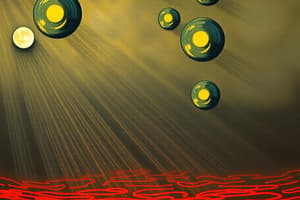Podcast
Questions and Answers
What is the primary mechanism through which heat transfer occurs when heated fluids move within a system?
What is the primary mechanism through which heat transfer occurs when heated fluids move within a system?
- Conduction
- Radiation
- Insulation
- Convection (correct)
Which of the following units is commonly used to measure temperature?
Which of the following units is commonly used to measure temperature?
- Kelvin (correct)
- Meters
- Moles
- Liters
In radiative heat transfer, how do the electromagnetic waves emitted by objects travel?
In radiative heat transfer, how do the electromagnetic waves emitted by objects travel?
- Via direct contact with other objects
- Through convection currents
- Through electromagnetic fields
- Across space (correct)
What form of heat transfer is responsible for warm air rising and creating weather patterns like clouds and storms?
What form of heat transfer is responsible for warm air rising and creating weather patterns like clouds and storms?
Which type of energy is associated with atoms and molecules due to their motion at various temperatures?
Which type of energy is associated with atoms and molecules due to their motion at various temperatures?
What type of heat transfer occurs when two objects at differing temperatures touch each other?
What type of heat transfer occurs when two objects at differing temperatures touch each other?
In which state of matter do particles conduct heat the best?
In which state of matter do particles conduct heat the best?
Which method of heat transfer is illustrated by sunlight warming Earth?
Which method of heat transfer is illustrated by sunlight warming Earth?
Why do many industrial applications require mixed modes of heat transfer?
Why do many industrial applications require mixed modes of heat transfer?
Study Notes
Heat and Energy: A Deeper Look into Transfer Mechanisms
Heat and energy are intertwined concepts vital to understanding life's processes and our world's intricate workings. In this exploration of heat and energy, we will delve specifically into the realm of heat transfer—the process by which thermal energy moves from one place to another. As with any science endeavor, clarity starts with definitions:
- Thermal Energy: This is kinetic energy associated with atoms and molecules due to their motion at various temperatures. High temperature corresponds to more significant molecular movement.
- Temperature: Measured using units such as degrees Celsius (({}^{\circ})C), Kelvin (K), or Fahrenheit (({}^{\circ}!F)), it indicates how hot or cold an object is relative to its surroundings.
Now let's examine three primary mechanisms through which heat may be transferred:
Convection
Convective heat transfer occurs when heated fluids move within a system. Hotter fluid rises while cooler liquid sinks via density differentials generated by temperature differences. For instance, warm air rising creates weather patterns like clouds and storms; similarly, water boiling forms bubbles that buoy upwards.
Radiation
Radiative heat transfer functions via electromagnetic waves emitted by objects due to their temperature. These waves travel across space until they strike other bodies, being absorbed, reflected, or transmitted upon contact. Some examples include sunlight warming Earth and visible light reflecting off mirrors.
Conduction
When two objects at differing temperatures touch each other, heat will flow from the higher to lower-temperature material. An excellent example of conduction is ice melting against a warm countertop. Solids conduct better than gases because particles are closer together.
It's essential to note that these methods often overlap during practical situations: In homes, heating systems employ radiators that utilize convection and radiation, while insulation prevents excessive loss of heat via conduction. Additionally, many industrial applications require mixed modes to maintain a balance between efficient operation and reasonable expenses.
To calculate the rate of heat transfer under specific conditions, engineers and scientists rely on equations developed based on fundamental principles. Here's a simple illustration of these formulas:
[ Q = mc \Delta T ]
where (Q) represents the amount of heat transferred, (m) is mass, (c) stands for specific heat capacity, and (\Delta T) denotes change in temperature.
Remember that you need not memorize all equations and formulas but instead maintain an appreciation for their significance in quantifying real-world phenomena related to heat and energy transfer.
Studying That Suits You
Use AI to generate personalized quizzes and flashcards to suit your learning preferences.
Description
Delve into the intricate world of heat and energy transfer mechanisms with this quiz. Learn about convection, radiation, and conduction - the three primary methods through which heat is transferred. Understand key concepts like thermal energy, temperature, and how engineers calculate heat transfer rates using fundamental equations.




